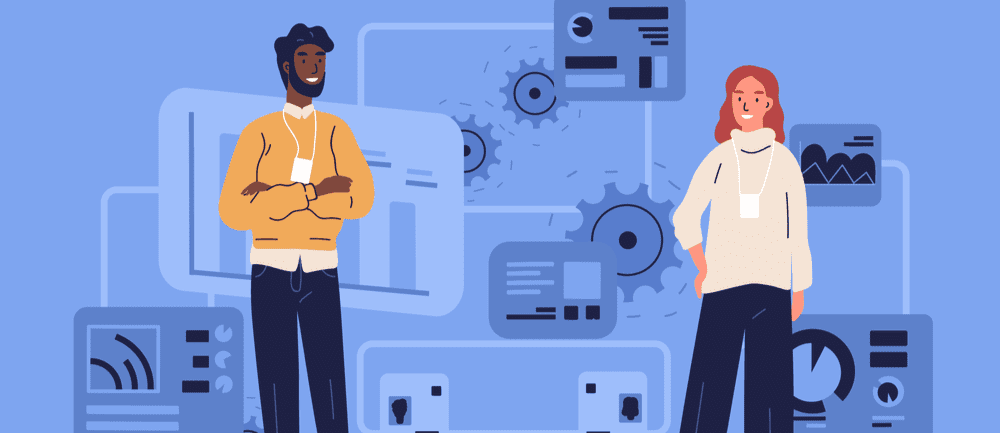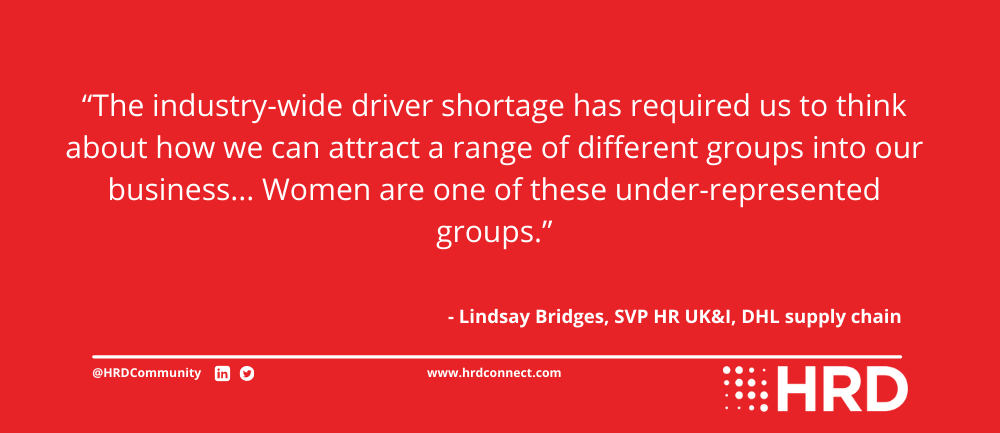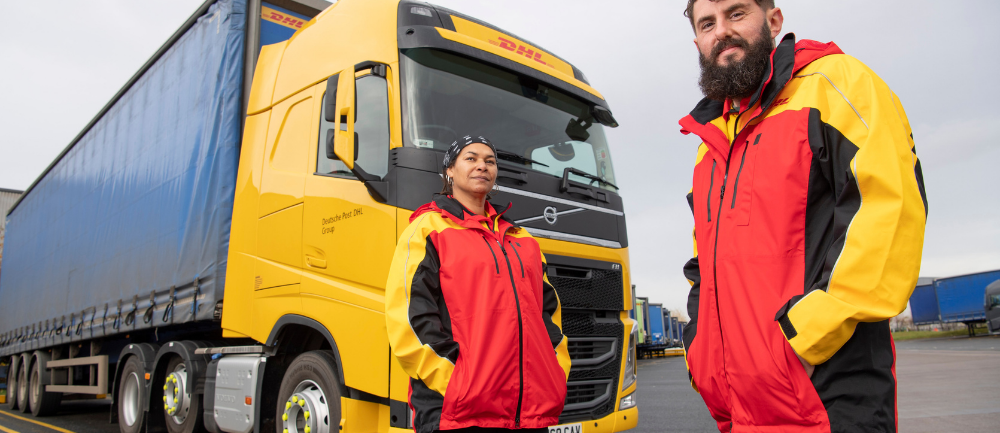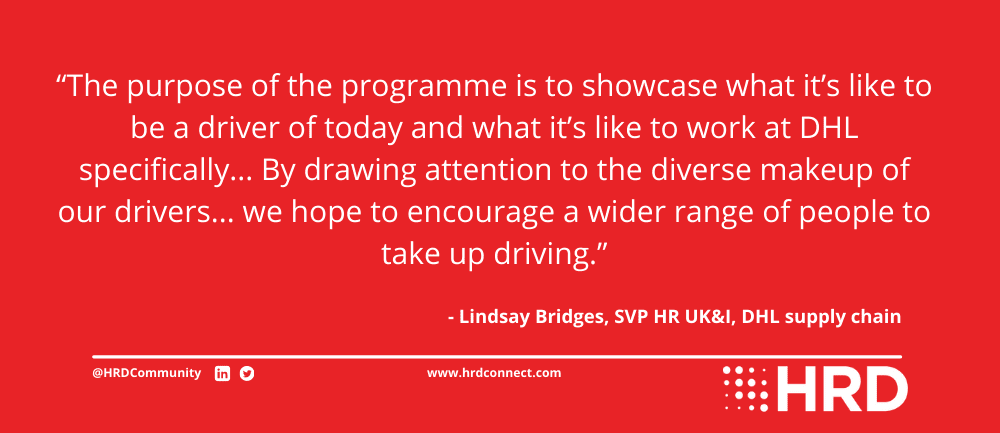-
Provided by

- Date published: Feb 25, 2022
- Categories
With 440,000 employees across 220 countries, DHL is one of the world’s leading logistics companies. The company, whose UK headquarters are in Milton Keynes, has recently embarked on a concerted drive to recruit more women, both among front-line drivers and in the C-suite.
Here Lindsay Bridges, SVP HR UK&I at DHL supply chain, talks us through this campaign and what it represents.
Run the briefest of Google searches on UK logistics and you’ll quickly discover two things.
- The UK faces a chronic shortage of qualified drivers.
- The drivers that are qualified are almost exclusively men.
The first trend is slightly tricky to explain — the product of societal changes, the greater range of career choices available to today’s young people and the ‘great resignation’ of European drivers in the wake of Brexit.
But the second phenomenon? Well, that’s easy. Driving has always been a man’s job, right? The long hours, the truckstop showers, the pot noodles in motorway service stations… it’s always just seemed such a blokey world.
In fact, it’s a problem at all levels of logistics. Women make up 47% of the UK workforce, but in the transport sector the figure drops to 20%. According to research carried out by Supply Chain Management Review in 2017, just 5% of senior supply chain roles at Fortune 500 logistics companies are in female hands.
Putting things right
Now, however, more and more bodies – both private companies and cross-industry organisations – are striving to redress the gender balance and encourage more women to enter the industry. And DHL’s Supply Chain unit is leading the way.
DHL has played a key role in Britain’s response to Covid-19. At the peak of the pandemic it delivered around 3,000 key lines of life-saving equipment from bases in Liverpool and nearby Skelmersdale to the new Nightingale hospitals; its patient transport team, meanwhile, has provided non-emergency ambulance services to patients diagnosed with Covid-19. And it has provided a critical supply chain network to support the manufacture and deliver of thousands of new ventilators.
But now DHL is striving to play a new role, as a champion of diverse workforces, with a firm accent on gender equality.

DHL has long been on point when it comes to inclusive, family-friendly values. It offers 13 weeks’ paid maternity leave as a minimum, and has rolled out initiatives such as discounted tutoring and family activity packs. So it is ideally placed to become a pioneer in the creation of a gender-balanced workforce, and smash some of the tired taboos that are dissuading women from a career in logistics.
“Our employer branding has focused on our key priorities of diversity & inclusion, learning & development, and sustainability,” Lindsay Bridges notes, “not least as we try to expand the pool of people we try to attract to a career in logistics.
“The logistics industry as a whole has traditionally been male-dominated, so our current focus on the recruitment of women is part of our ongoing ambition to address the gender imbalance.”
“The driver shortage has made us think”
The recruitment of drivers is a key priority within this overall framework. Around 98% of all UK commercial drivers are currently men, so there is a huge untapped talent pool to explore.
“The industry-wide driver shortage has required us to think about how we can attract a range of different groups into our business,” Lindsay says. “Women are one of these under-represented groups.”
This priority is clearly evident in DHL’s Driving Ambition programme, a fully funded licence acquisition scheme that is particularly aimed at non-traditional applicant groups.
The programme provides free driver training worth up to £3,000, comprising both real-world training and simulator sessions provided via a travelling classroom. Applicants can obtain either a Category C licence (Class 2) to drive rigid trucks, or licences C and E (Class 1) to drive articulated lorries.
All new employees are invited to join DHL’s pension scheme, along with accessing a range of exclusive wellbeing benefits such as mortgage advice, online tutoring for kids and a free online GP service, plus retail and supermarket discounts of up to 10%.

Moving through the gears
In parallel, DHL is striving to increase the number of women in office-based roles. This starts at graduate level; Lindsay and her team have poured over the materials they use for assessment days, and undertaken a painstaking process to decode the gender-exclusive language of their communications, including the application form. Any vocabulary which may discourage women, or other ethnic groups, has been rooted out and eliminated.
For those already with the company, a fledgling initiative called Shift Up A Gear supports the progression and placement of female candidates for management positions by offering bespoke and targeted support for career development.
Women taking part in Shift up a Gear are matched to a member of the management team, which is designed to raise their visibility within the organisation. Looking longer-term, programme members are offered coaching or advice from a mentor, who can be either male or female.
Finally, a string of female-focused career workshops, and a senior leaders conference, give colleagues the chance to learn from other successful women from across the DHL organisation.

“We want to showcase what it’s like”
But none of this development, opportunity and progress will mean anything if it is not communicated effectively, through the identification of role models who can inspire the next generation.
Various thinkpieces have identified the role of role models in encouraging women into non-traditional industries such as logistics. By sharing their stories, these female pioneers can highlight the possibilities of their sector and create a pathway for new entrants.
In an opinion piece published in February 2020, the editor of Logistics Manager wrote that “more women will enter the sector if they see visible role-models and leaders of business in logistics. They will aspire to a career in logistics… to be successful in business.”
So DHL has launched a coordinated programme of brand awareness, designed to open up recruitment to non-traditional sources.
At driver level, the programme is embodied by a network of ambassadors who appear in DHL’s recruitment materials, video campaigns, social media, and in photography used on trailers. Involvement is entirely voluntary and drivers can choose the promotional activities they want to participate in.
“The purpose of the programme is to showcase what it’s like to be a driver of today and what it’s like to work at DHL specifically,” Lindsay explains. “This network of drivers is then called upon for internal and external promotion of our driver community.
“By drawing attention to the diverse makeup of our drivers, and sharing their life stories, we hope to encourage a wider range of people to take up driving.”

This is augmented through SmartConnect, DHL’s internal engagement platform. The company’s interal comms team publishes regular blog posts and articles about recruiting women [“this always get a really positive response from colleagues”, Lindsay says] and uses forums to identify painpoints around the recruitment of drivers, which are shared throughout the business.
Externally, DHL has collaborated with the Department for Transport on a social campaign to promote diversity and attract women. Female drivers feature regularly on these campaigns, both to outline their daily routine and explain why they find their role as a driver rewarding.
DHL notched a major milestone at the end of 2021, when roads minister Baroness Vere visited the company’s Transport Development Centre, which has been repurposed to create a central hub for Driving Ambition training. During the event, a female driver who graduated from the programme spoke to the minister about her positive experience, and explained to viewers and attendees what the initiative involves in practice.
Greenshoots emerging
As yet, it is too early to say whether the push for gender diversity has been a success at driver level. However, there is clear evidence that the balance is tipping at more senior levels; across the entire DHL organisation, over one in five mid-to-upper-level management positions is now held by women (23.2%). Under the terms of their Strategy 2025 document, DHL’s people leaders want this figure to reach 30% within the next three years.
The greenshoots are sprouting at lower level, too. Lindsay says she and her colleagues have maintained a high volume of offers to women in their recruitment process, and this is backed up by the stats. This year, 48% of new starters on DHL’s Future Leader Graduate Programme were female.
“This is a great achievement, and one we hope to build on in years to come,” Lindsay says. “We recognise that if we want to create long-term change to the future management profile we need to bring in more diversity with recruits at the start of their career.”

Indeed, Lindsay says that in 2022 she and her colleagues “will be focussing on talking to talent in the spaces that feel natural for them, and in ways that feel natural.” Over the past year, the recruitment leads have ramped up their activities on social media channels such as LinkedIn, Twitter and Facebook, backed up by a programme of virtual events. This focus will be further entrenched over the months ahead, as DHL takes a proactive approach to building a balanced workforce for the future.
At the same time, the people team will strive to showcase the real people working for DHL, so prospective hires can see the possibilities available to them. The stream of videos, blog posts and social messages will continue, and female employees will have a key role to play.
Genuine change won’t happen overnight. The barriers facing women in logistics remain deeply entrenched, and it will take time for the taboos and stigmas to be cleansed.
However, DHL’s intentions are clear: the old, macho culture of logistics is gone forever. To build a supply chain that can seize digital opportunities and maximise efficiencies at a time of unprecedented resource strain, we need to find talent from everywhere. This can no longer be a man’s world.
